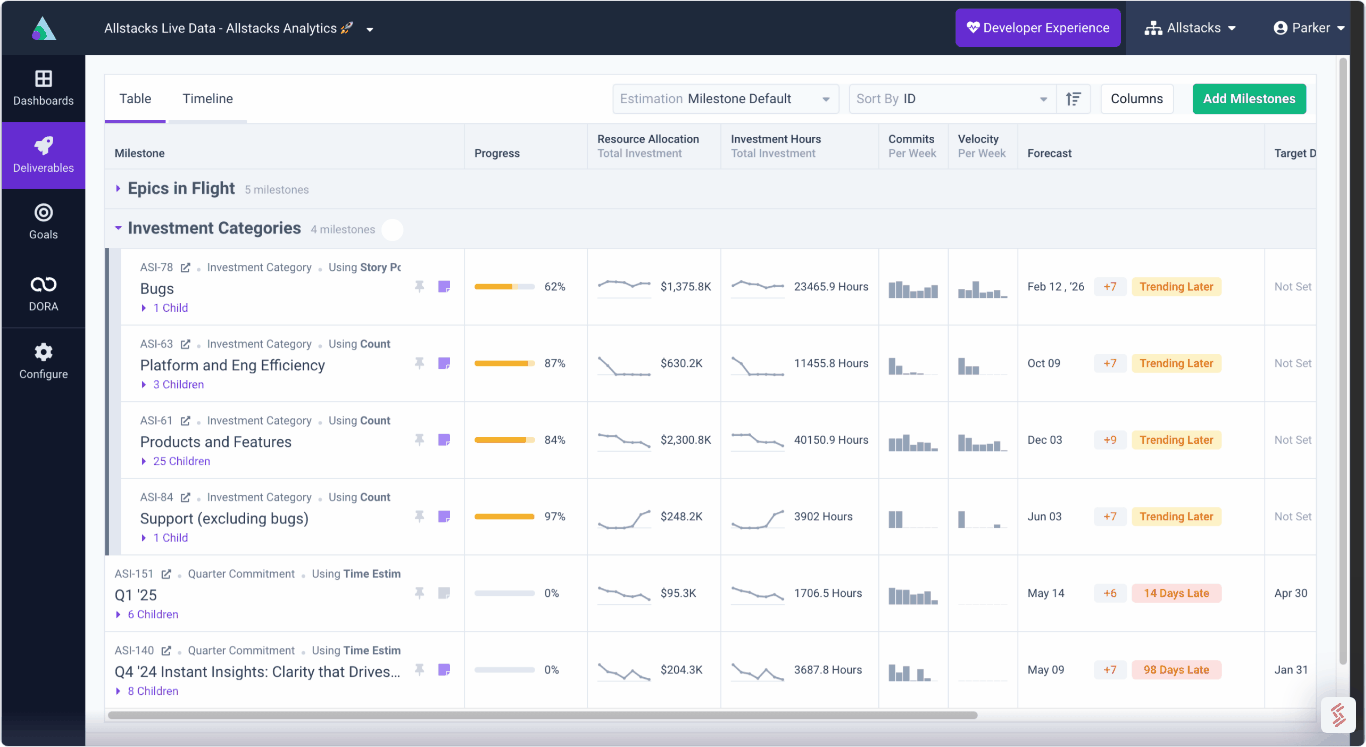.png)
Software Engineering Intelligence
-
Intelligence Engine
On-demand exhaustive AI-analysis
-
Engineering Investment
Complete visibility into time & dollars spent
-
360º Insights
Create meaningful reports and dashboards
-
Project Forecasting
Track and forecast all deliverables
DevEx
-
Developer Surveys
Create and share developer surveys
Software Capitalization
-
R&D Capitalization Reporting
Align and track development costs
CIO Top Investment Priorities - Upgrades and Continuity
We talk about two more investment priorities of CIO’s: upgrades and continuity and how Allstacks can help leaders manage both to meet their goals.

Application Upgrades: When does upgrading dev tooling pay off?
As a leader, you are no stranger to change. Legacy systems that were once breakthroughs may no longer be able to meet the changing needs of your organization. Perhaps they are too clunky or dispersed across your shifting organization, or maybe your business has changed, and you’re trying to catch up to a changing market. Whatever the case may be, you are faced with a set of decisions that can change the direction of your team and organization for the next decade. Upgrading applications and tooling across the organization requires more than just changing software; It also requires activities, processes, and interactions to shift. These decisions cannot be made lightly.
On the other hand, development teams are always clamoring for the next new exciting platforms and technologies. As a CIO, you are ultimately responsible for balancing the new efficiencies of a faster, better horse with the cost of re-positioning and navigating the complexities of the horses you already have. In other words, you have to both play gatekeeper and visionary in equal measure.
While it can be hard to decipher which options deliver the value they promise, we make it apparent and straightforward from the start. Allstacks can give you measurable data on how shifting and improving your workflows for your engineering team impacts your bottom line. We can help you understand if your organization will really improve from moving to a new build system [e.g.,” My builds take forever. We need to upgrade this!” - Dev teams], or if switching project management tools will be a huge cost with no clear benefits.
Given your team’s work patterns and performance, Allstacks can help you decide which strategies, upgrades, and activities are best so you can de-risk the decision-making process. Once you’ve made your decision, Allstacks provides complete visibility, so you can see and measure the impact of your efforts.
Instead of hoping you realize the gains promised by the persuasive sales representative, we help your organization make strategic decisions with data. By arming your team with the data to make tough calls, you can empower your teams and provide informed resistance where needed.
Business/IT continuity
Things will go wrong.
It’s critically important to make sure customers, users, employees, and everyone that depends on your business always have a consistent and great experience. It is your job to establish the best possible plans to help mitigate outages and damage when things go south. If you *are* able to be perfect, then we need you to tell us your secret!
For the rest of you, let’s talk about how Allstacks can help you plan for, respond to, and succeed despite breaks in business and IT continuity.
You likely have plans in place that direct your teams with specific protocols and mitigation strategies. Your organization knows that if “this” happens, we should do “that.” We get it. You want to achieve a set of specific, seamless experiences for your users inside and outside the organization. These business continuity goals are critical, and while the high-level goal is relatively straightforward, it gets more complex to track all of the contributing factors. Allstacks provides clear insights into how quickly dev helps you reach these lofty goals.
Often, a good measure of org and dev team success is how well your organization and teams respond under pressure. Nothing puts the pressure on a development team like a significant outage. We’ve been there - a major service goes down, and suddenly millions of users are affected. Allstacks can show you how quickly and effectively your teams can respond to specific issues.
Across various teams, it’s important to know how quickly your team can respond under pressure. Shortening the find-fix cycles, for instance, not only helps your teams deliver more value to your organization but also provides you with clear and measurable enhancements for your team’s performance. Streamlining the cycle that identifies AND fixes critical customer issues quickly would be a success.
You know what success should look like, but Allstacks helps dig into the details so you can measure and address risks before they become outages.
Try Allstacks out for yourself, and then head over to Part 3 in this series.

